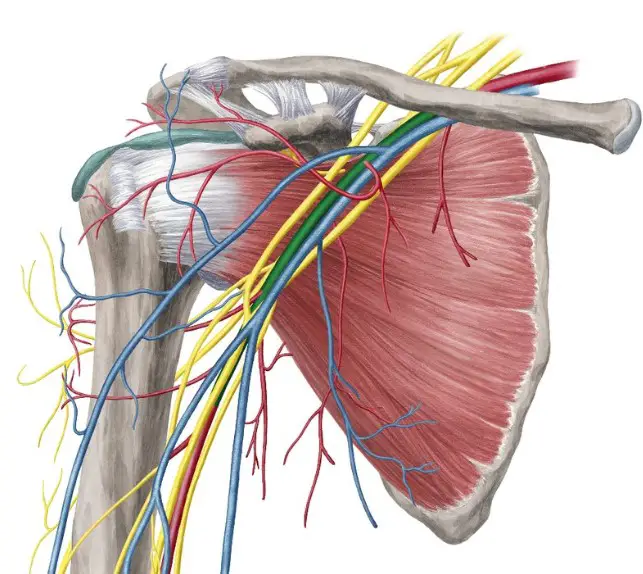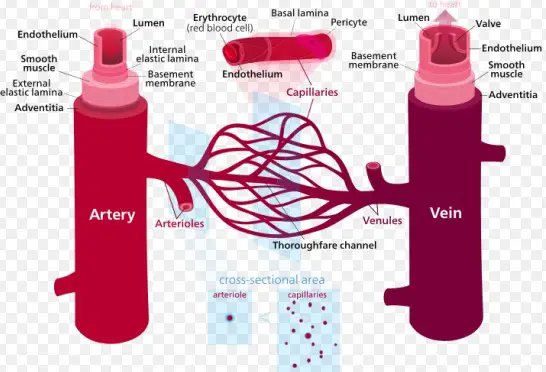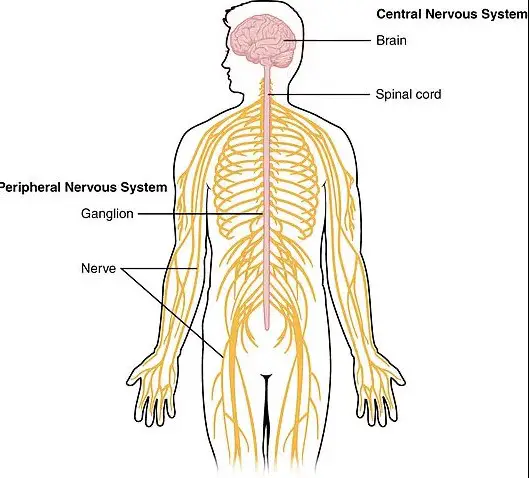The human body is an intricate network of systems working together to maintain life. Two critical components of this network are the nerves and blood vessels. While both are essential for the body’s functionality, they serve vastly different roles. Nerves act as the body’s communication system, transmitting signals to and from the brain, while blood vessels form a complex transportation network that circulates blood throughout the body.
Nerves and blood vessels differ primarily in their structure and function. Nerves consist of neurons and their extensions, responsible for carrying electrical signals that control the body’s responses to various stimuli. In contrast, blood vessels, comprising arteries, veins, and capillaries, transport blood enriched with oxygen and nutrients to tissues and remove waste products. Understanding these differences is crucial for grasping how the body maintains its complex internal environment.
The distinction between nerves and blood vessels extends beyond their basic functions, impacting health, disease management, and medical treatments. Disorders affecting these systems can lead to significant health issues, with symptoms ranging from mild discomfort to life-threatening conditions. Recognizing the differences between them is not only fascinating from a biological standpoint but also vital for identifying and treating related health conditions effectively.

Anatomy Basics
The human body is a marvel of engineering, comprising numerous systems that work in harmony to maintain life. Among these, the nervous and circulatory systems are crucial for the body’s functionality. Understanding the basic anatomy of these systems, specifically nerves and blood vessels, is essential for grasping their roles in our health and well-being.
Nerve Structure
Neurons: The Building Blocks
At the heart of the nervous system are neurons, specialized cells designed to transmit signals efficiently. Neurons consist of three main parts:
- Cell body (soma): Contains the nucleus and is the neuron’s metabolic center.
- Dendrites: Receive signals from other neurons.
- Axon: Transmits signals away from the neuron.
Neurons communicate through synapses, junctions where the axon tip of one neuron can transfer signals to another neuron’s dendrite or cell body.
Nerve Fibers and Protective Sheaths
Nerve fibers are long extensions of neurons, primarily axons, that transmit electrical impulses over distances within the body. These fibers are insulated by protective sheaths, which are crucial for fast signal transmission. The most well-known sheath is the myelin sheath, a fatty layer that not only protects but also speeds up the transmission of nerve impulses.
Blood Vessel Structure
Arteries, Veins, and Capillaries
Blood vessels are the body’s highways, transporting blood to every cell. There are three main types of blood vessels:
- Arteries: Carry oxygen-rich blood away from the heart.
- Veins: Return oxygen-poor blood back to the heart.
- Capillaries: Tiny vessels that connect arteries and veins, facilitating the exchange of oxygen, nutrients, and waste between blood and tissues.
The Layers of Blood Vessels
Each blood vessel type has its unique structure, but generally, they are composed of three layers:
- Intima: The innermost layer, which is smooth to allow easy blood flow.
- Media: The middle layer, containing smooth muscle and elastic fibers to regulate blood pressure.
- Adventitia: The outer layer, providing structural support and flexibility.
Functional Differences
Nerve Functions
Nerves play a pivotal role in both receiving sensory information from the external and internal environments and in directing motor responses. This dual function is divided as follows:
- Sensory input: Nerves detect changes and transmit information about them to the brain.
- Motor output: Nerves relay commands from the brain to muscles and glands, initiating action.
Blood Vessel Functions
Blood vessels, on the other hand, are primarily involved in the transport of substances. Their key functions include:
- Oxygen and nutrient transport: Arteries and capillaries deliver essential nutrients and oxygen to tissues.
- Waste removal: Veins and capillaries help in removing carbon dioxide and metabolic wastes from tissues.
Pathways and Connections
Nerve Pathways
Nerve signals travel through complex pathways in the body. This journey begins at sensory receptors, passes through neural networks in the central nervous system, and ends at effector sites, such as muscles or glands, orchestrating a coordinated response to stimuli.
Blood Vessel Circulation
The circulatory system, with the heart at its core, ensures that blood flows continuously through the body. This system is divided into two main circuits:
- Systemic circulation: Oxygen-rich blood is pumped from the heart to the body and back.
- Pulmonary circulation: Oxygen-poor blood is sent to the lungs to be oxygenated, then returned to the heart.
In both nerves and blood vessels, these pathways and connections are vital for maintaining the body’s internal balance and responding to external changes.

Health Implications
Understanding the health implications of both nerve and blood vessel disorders is crucial for early diagnosis and effective treatment. These conditions can significantly impact quality of life and may lead to serious health issues if left unaddressed.
Nerve Disorders
Neuropathy
Neuropathy, or peripheral neuropathy, is a term used to describe a variety of conditions that involve damage to the peripheral nerves. Symptoms often include numbness, tingling, and pain, typically in the hands and feet. Various factors can cause neuropathy, including diabetes, infections, toxins, and genetic predispositions. The management of underlying conditions and symptomatic relief are primary treatment approaches.
Multiple Sclerosis
Multiple Sclerosis (MS) is an autoimmune disorder that affects the central nervous system, leading to the destruction of the myelin sheath. This results in communication problems between the brain and the rest of the body. Symptoms can range from fatigue and difficulty walking to more severe cases of vision loss and impaired coordination. While there is no cure, treatments focus on speeding recovery from attacks, slowing disease progression, and managing symptoms.
Blood Vessel Disorders
Hypertension
Hypertension, or high blood pressure, is a common condition where the force of the blood against artery walls is too high, potentially leading to health issues such as heart disease and stroke. Lifestyle changes, such as eating a healthier diet, exercising regularly, and quitting smoking, along with medication, can manage hypertension effectively.
Atherosclerosis
Atherosclerosis involves the build-up of plaques in the arteries, which can restrict blood flow and lead to cardiovascular diseases. Factors contributing to atherosclerosis include high cholesterol, smoking, and high blood pressure. Treatment focuses on lifestyle modifications and medications to lower risk factors.
Diagnostic and Treatment Approaches
Diagnosing Nerve Conditions
Electromyography (EMG) and Nerve Conduction Studies
These diagnostic tests measure the electrical activity of muscles and the speed of nerve signals. They are essential for diagnosing conditions like neuropathy and are often performed together to provide a comprehensive overview of nerve function.
Diagnosing Blood Vessel Conditions
Angiography
Angiography is a medical imaging technique used to visualize the inside of blood vessels and organs of the body, particularly the arteries, veins, and heart chambers. This is done by injecting a contrast dye into the blood vessels and then taking X-rays to see how the blood flows through them. It’s crucial for identifying blockages and abnormalities in the circulatory system.
Ultrasound
Ultrasound uses high-frequency sound waves to create images of the inside of the body. It can show how blood flows through the vessels and is a non-invasive method for detecting blood vessel problems, such as blockages and narrowing.
Treatment Strategies
The treatment of nerve and blood vessel disorders may involve medication, surgery, and lifestyle changes, depending on the severity and underlying cause of the condition.
- Medications can include pain relievers, anti-inflammatory drugs, and drugs to manage symptoms or underlying conditions.
- Surgery might be necessary in severe cases, such as for certain types of neuropathy or advanced atherosclerosis, to remove blockages or repair damaged vessels and nerves.
- Lifestyle changes are often the first line of treatment, particularly for blood vessel disorders. This includes eating a healthy diet, exercising, managing stress, and quitting smoking.
Research and Innovations
Current Research
Ongoing research into nerve and blood vessel disorders focuses on understanding the underlying mechanisms, improving diagnostic methods, and finding more effective treatments. This includes studies on gene therapy, stem cell treatments, and new medications to slow disease progression and relieve symptoms.
Innovative Treatments
Recent innovations in treating these conditions include the development of targeted therapy for specific types of nerve damage and minimally invasive surgery techniques for blood vessel disorders. These advancements offer hope for more effective treatments with fewer side effects and quicker recovery times.
Frequently Asked Questions
What are the main functions of nerves and blood vessels?
Nerves are responsible for transmitting electrical signals throughout the body, facilitating communication between the brain and various body parts. This allows for sensory perception and the coordination of muscle movements. On the other hand, blood vessels transport blood, which carries oxygen and nutrients to tissues, and removes carbon dioxide and waste products, thus maintaining the body’s internal balance.
How do nerve and blood vessel disorders differ?
Nerve disorders typically affect the body’s ability to send and receive signals, leading to symptoms like pain, numbness, and muscle weakness. Common nerve disorders include neuropathy and multiple sclerosis. Blood vessel disorders, such as hypertension and atherosclerosis, impact the circulation of blood, which can lead to heart disease, stroke, and other cardiovascular conditions.
Can nerve and blood vessel health be improved?
Yes, the health of both nerves and blood vessels can be improved with lifestyle changes, medication, and in some cases, surgical interventions. Regular exercise, a balanced diet, avoiding tobacco and excessive alcohol, and managing stress can significantly enhance the function and longevity of these crucial systems. For specific conditions, targeted treatments and therapies are available, emphasizing the importance of early diagnosis and management.
Conclusion
Understanding the differences between nerves and blood vessels is more than an academic exercise; it’s essential for appreciating the complexity and resilience of the human body. The distinct roles and functions of these two systems underscore the body’s incredible ability to communicate internally and maintain homeostasis.
Awareness and knowledge of how these systems operate not only enrich our understanding of human biology but also emphasize the importance of maintaining their health. Through preventive measures, early detection, and appropriate treatments, we can effectively manage disorders affecting these vital networks, leading to better overall health and well-being.

